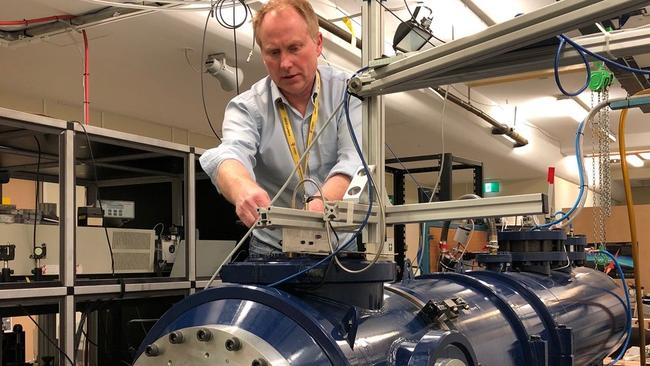Sky’s the limit in overcoming literal hypersonic warp speed
A Canberra hypersonics experiment has been selected as a test case for a NASA-organised workshop in the US which will inform the design of vehicles that travel at hypersonic speeds.

When an aircraft travels at several times the speed of sound, it distorts in flight due to the extreme heat and aerodynamic load it is being subject to. The aircraft will likely not fly as well and will weaken.
It’s a problem Professor Andrew Neely and his colleagues from the University of NSW at Canberra’s Australian Defence Force Academy are working to help solve.
His hypersonics experiment has been selected as a test case for a NASA-organised workshop in the US next year which will inform the design of vehicles that travel at hypersonic speeds.
The Aeroelastic Prediction Workshops will bring together an international community of engineers and researchers who use computer simulations to model the complex physics of aeroelasticity and fluid-structure interactions.
“This is a fundamental study of the complex coupled physics that will influence how a hypersonic vehicle will distort in flight due to the extreme aerodynamic and thermal loads that it is subjected to,” Professor Neely says. “It will help inform the development of computational tools to help confidently and efficiently design these vehicles.”
All high-speed aircraft are subject to some degree of heating and distortion – this is one of the factors which limited the Concorde to Mach 2 or twice the speed of sound – but the problem is more acute for hypersonic aircraft.
The definition of hypersonic isn’t fixed, but is generally agreed to be five times or more the speed of sound. As aircraft become more hypersonic, the heating effects of the friction caused by air particles flowing around the aircraft start to become very important.
“It’s very important then to look at how the vehicle could distort or bend in flight and interact with the flow around it,” Neely says.
Not only do aircraft distort, affecting the performance, individual panels can vibrate at high speeds in a phenomenon known as flutter. This can eventually weaken parts of an aircraft by way of structural fatigue, in a similar way that repeatedly bending a paperclip back and forth will eventually snap it.
For aircraft designers, this leads to a trade-off.
“One of the challenges for designing any aircraft is to trade off the rigidity of the aircraft versus the mass of the aircraft,” Neely says. “Because you can always make something more rigid and stronger by thickening up the structural members. But very quickly your aircraft becomes too heavy and so either you can’t fly as far or for as long or carry as much payload. So your mission requirements become very constrained.
“It’s always harder the faster you want to push, the more powerful your engine, the more fuel therefore you have to carry.
“So mass can be an even bigger consideration for high-speed vehicles such as hypersonic vehicles.”
The UNSW Canberra experiment is aimed at testing simplified versions of the problems of hypersonic design and aerodynamics and providing data which engineers designing hypersonic aircraft can draw on.
One of the problems of designing hypersonic aircraft is there is almost no test flying because it is very challenging and very difficult, so there is very little actual flight data for engineers to validate and test their designs against. Additionally, calculating complex flow physics is computationally very expensive because it requires intricate modelling which can take weeks to run in a computer simulation.
“That’s not good for an engineering designer,” Neely says. “An engineer wants to be able try out different designs early on the design process very quickly.”
Hypersonics will have several applications across both the defence and civilian domains.
At its most basic level it is about speed, rapid acceleration and getting from A to B more quickly.
The US military has publicly talked about using the capabilities for high-speed transport of VIP and to deploy special forces very quickly. But transport of people is still some way off, Neely says. Before that will likely be reusable unmanned flight, for things such as surveillance and intelligence gathering. And the research will be used for rockets for companies such as Elon Musk’s SpaceX, which are hugely expensive to replace.
“Imagine Qantas throwing away an aircraft after every flight,” says Neely. “The closest we’ve got to truly reusable hypersonic vehicles are probably the Falcon 9 rockets from SpaceX. Those are briefly hypersonic and they are rapidly reusable. They’re at the point of reusing those within a few weeks.
“So we’re getting there.
“They have to think about when they design that, trading off mass against allowing it to perform its mission each time – but then also allowing it to not age too quickly.
Russia claims to have deployed hypersonic missiles aimed at military targets during its invasion of the Ukraine, making it the first country to ever test this type of missile in combat.
Neely notes that ICBM missiles from the 1950s were also hypersonic, but the newer classes of weapons are potentially far more manoeuvrable and therefore harder to detect and harder to defeat requiring rapid investment in counter measures.


